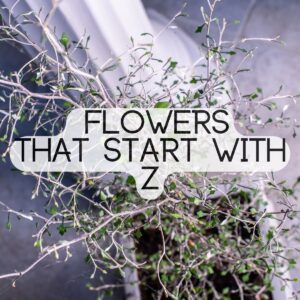These flowers that start with J are a bright and cheery collection of flowers to keep in your yard, patio, and garden for blooms to enjoy! From the amazingly lovely Jaborosa to the many varieties of Jasmine, there are sure to be some of your new favorites here too!

Read Next
Jaborosa
Scientific Name: Jaborosa integrifolia
Type Of Flower: Perennial
When Do They Bloom? Late Spring & Summer
Jaborosa is a showy flower that produces beautiful five-petal blooms which are white or cream-colored. The flowers of this plant are fragrant but won’t last once their petals have been exposed to water.
Native to Brazil, these plants require an ample amount of sunlight and well-draining soil to thrive. Jaborosa plants need their own space to grow so be sure to plant them at least one foot apart from each other and other plants.
Quick Fact: Jaborosa is also called spring blossom!
Jacob's Ladder



Scientific Name: Polemonium caeruleum
Type Of Flower: Herbaceous Perennial
When Do They Bloom? Spring & Summer
Jacob’s ladder isn’t just a game from your childhood! It is the name of a beautiful species of bell-shaped flowers. The flowers of this plant can be white, pink, yellow, blue, or purple, and often they have a simple yellow center.
These plants can be grown in shaded areas and grow to be about 2 feet in height. These fragrant plants are a stunning addition to any garden, your nose will also thank you!
Quick Fact: Jacob’s ladder plants are also called Greek valerian plants!
Jamesia americana
Scientific Name: Jamesia americana
Type Of Flower: Perennial
When Do They Bloom? Spring & Summer
Jamesia americana is a plant that produces small, delicate white and pink flowers that are sometimes clustered together. They are a type of hydrangea plant and often grow up to be 6 feet tall!
These plants grow in the United States, often found in the Rocky Mountain states. This five-petal flower is known for its love of sandy soil and ability to thrive in partial sun.
Quick Fact: Jamesia americana plants are also known as five-petal cliff bush!
Jasmine (Orange)
Scientific Name: Murraya paniculata
Type Of Flower: Shrub
When Do They Bloom? Spring, Summer, & Fall
There are many different varieties of the jasmine plant. Orange jasmine is an evergreen shrub that produces ultra-fragrant white flowers that are clustered together along with bright red berries.
This plant is a showstopper that can grow to be up to 12 feet tall and can be grown outside or indoors. Place your jasmine plants in full or partial sunlight and have an abundance of patients for this slow-growing plant!
Quick Fact: Orange jasmine plants can also be called satinwood or mock orange plants!
Jonquil



Scientific Name: Narcissus jonquilla
Type Of Flower: Perennial & Bulb
When Do They Bloom? April & May
Jonquil plants are a spring favorite! These plants are a type of daffodil. They have perky yellow blooms that appear around Easter and brighten up many gardens and pathways.
Jonquil plants are true lovers of sunshine and require full sun to produce their best blooms. Be sure to plant them in well-draining soil that is slightly acidic to give them a boost for ultimate growth potential.
Quick Fact: Jonquil is toxic to humans, cats, and dogs.
Japanese Anemone
Scientific Name: Anemone tomentosa
Type Of Flower: Perennial
When Do They Bloom? Late Summer & Fall
The Japanese anemone is a slow-growing plant that produces elegant white and pink flowers that do not require you to be an expert gardener. Enjoy these lovely plants in your garden, or add them as fresh-cut flowers to your favorite vase!
The Japanese anemone is native to China but is widely grown in Japan. There are multiple varieties of this plant, and they grow best in areas where they receive full sunshine.
Quick Fact: The Japanese anemone is resistant to pests such as rabbits and deer!
Japanese Iris
Scientific Name: Iris ensata
Type Of Flower: Herbaceous Perennial
When Do They Bloom? Summer
The Japanese Iris is a bold flower that can be beautiful shades of blue, purple, pink, or white. They are a bit finicky at first, so be sure to establish a green thumb before planting them!
These plants are fond of wet soil and moist conditions, which makes damp areas an ideal growing location as long as they can also receive some sunlight. They often grow to be between 2 and 4 feet in height, which makes them quite a great addition to your garden!
Quick Fact: The Japanese Iris is toxic for humans and animals!
Jerusalem Artichoke
Scientific Name: Helianthus tuberosus
Type Of Flower: Herbaceous Perennial
When Do They Bloom? Summer & Early Fall
The Jerusalem artichoke is a delicious root vegetable that produces lovely yellow flowers. These root vegetables are native to North America and grow rather quickly.
This plant is a great choice for beginners due to its ability to thrive in many conditions, ideally, Jerusalem artichokes need moist soil and full sunlight to partial shade!
Quick Fact: Jerusalem artichokes and globe artichokes are not related!
Jewelweed
Scientific Name: Impatiens capensis
Type Of Flower: Annual
When Do They Bloom? Summer & Fall
Jewelweed is a delicate plant that produces orange and yellow flowers that appear to shine when water droplets hit their petals. They are quite fragile with weak stems and flowers that slit open with a single touch.
This plant grows to be up to 5 feet tall and is native to North America. They thrive in soggy soil and shaded corners, which makes them ideal for areas where other plants can’t grow.
Quick Fact: Jewelweed is also called spotted touch me not!
Joe Pye Weed
Scientific Name: Eutrochium spp.
Type Of Flower: Herbaceous Perennial
When Do They Bloom? Summer
This silly-named plant is fragrant and attracts many pollinators such as bees and butterflies. Joe Pye weed is a quick grower and produces pinkish-purple flowers that smell similar to vanilla.
Joe Pye weed is quick growing and often reaches 7 feet in height when exposed to full sunlight. Native to North America, this plant is a great addition to gardens but is also considered a wildflower that is found along roadways and other natural landscapes.
Quick Fact: Joe pye weed is known to spread quickly and should be monitored to keep it from taking over!
Joseph’s Coat



Scientific Name: Alternanthera ficoidea
Type Of Flower: Perennial
When Do They Bloom? Fall
Joseph’s coat is an easy-to-care-for plant that is often used as a ground cover for gardens. Although, some varieties grow taller and are better suited for borders or indoor houseplants.
Joseph’s coat is native to South and Central America. It is best grown in full sun to help sprout its white blooms, but it is better known for its deep purple or vibrant pink foliage.
Quick Fact: Joseph’s coat is also called joy weed!
Juniper (Creeping)
Scientific Name: Juniperus horizontalis
Type Of Flower: Shrub & Groundcover
When Do They Bloom? Spring
Creeping juniper is not just planted for its small white flowers, but for its ability to prevent soil from eroding on sloped landscapes.
Plant creeping juniper in areas that receive full sun and well-drained soil, but be sure that it isn’t disturbed by too much traffic as this will hinder its growth.
Quick Fact: Creeping juniper is also called creeping cedar!





Comments
No Comments